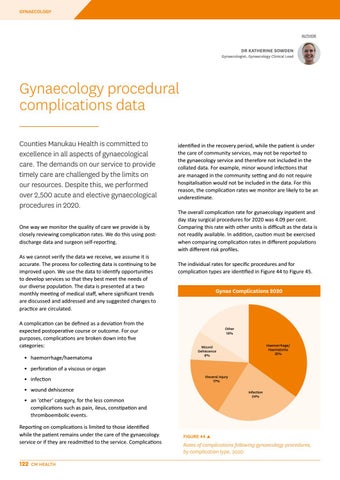GYNAECOLOGY
AUTHOR
DR KATHERINE SOWDEN
Gynaecologist, Gynaecology Clinical Lead
Gynaecology procedural complications data Counties Manukau Health is committed to excellence in all aspects of gynaecological care. The demands on our service to provide timely care are challenged by the limits on our resources. Despite this, we performed over 2,500 acute and elective gynaecological procedures in 2020. One way we monitor the quality of care we provide is by closely reviewing complication rates. We do this using postdischarge data and surgeon self-reporting. As we cannot verify the data we receive, we assume it is accurate. The process for collecting data is continuing to be improved upon. We use the data to identify opportunities to develop services so that they best meet the needs of our diverse population. The data is presented at a two monthly meeting of medical staff, where significant trends are discussed and addressed and any suggested changes to practice are circulated. A complication can be defined as a deviation from the expected postoperative course or outcome. For our purposes, complications are broken down into five categories: • haemorrhage/haematoma
identified in the recovery period, while the patient is under the care of community services, may not be reported to the gynaecology service and therefore not included in the collated data. For example, minor wound infections that are managed in the community setting and do not require hospitalisation would not be included in the data. For this reason, the complication rates we monitor are likely to be an underestimate. The overall complication rate for gynaecology inpatient and day stay surgical procedures for 2020 was 4.09 per cent. Comparing this rate with other units is difficult as the data is not readily available. In addition, caution must be exercised when comparing complication rates in different populations with different risk profiles. The individual rates for specific procedures and for complication types are identified in Figure 44 to Figure 45.
Gynae Complications 2020
Other 16% Haemorrhage/ Haematoma 35%
Wound Dehiscence 8%
• perforation of a viscous or organ • infection
Visceral Injury 17%
• wound dehiscence
Infection 24%
• an ‘other’ category, for the less common complications such as pain, ileus, constipation and thromboembolic events. Reporting on complications is limited to those identified while the patient remains under the care of the gynaecology service or if they are readmitted to the service. Complications
122 CM HEALTH
Figure 44
Rates of complications following gynaecology procedures, by complication type, 2020






















